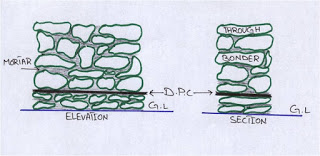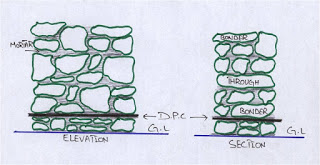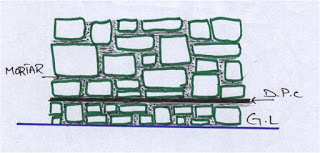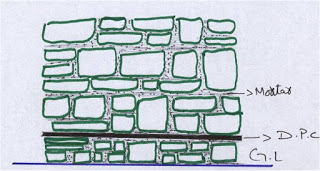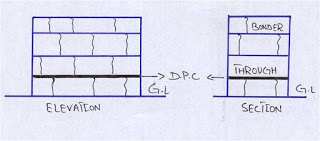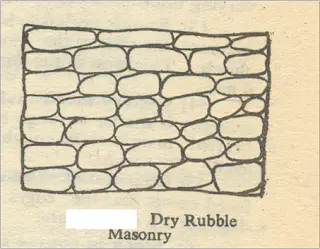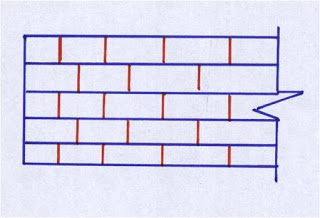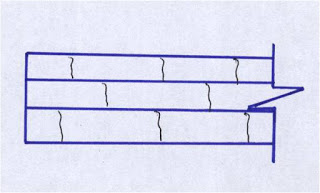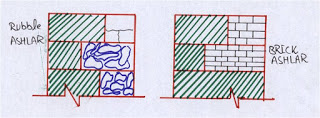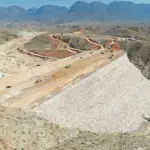Rock, that is removed from its natural site and generally, cut or dressed and then finished for building purposes, is called \”Stone\” and the art of building the structure with stones as constructional units is called \”Stone Masonry\”.
(1) Rubble Masonry
(2) Ashlar Masonry
Rubble Masonry
The stone masonry in which either undressed or roughly dressed stones are laid is called \”Rubble masonry\”.
In this masonry, the joints of mortar are not of uniform thickness.
Types of Rubble Masonry
(a) Random Rubble masonry
(i) Uncoursed random rubble Masonry
(ii) Built to courses random rubble Masonry
(b) Squared Rubble
(i) Uncoursed squared rubble Masonry
(ii) Built to courses squared rubble Masonry
(iii) Regular coursed squared rubble Masonry
(c) Dry rubble masonry
Random Rubble Masonry
The rubble masonry in which either undressed or hammer dressed stones are used is called \”Random Rubble Masonry\”.
The strength of this masonary depends upon the bond between the stones.
The bond should be sound both transversely and longitudinally.
Transverse bond is obtained by the liberal use of \”Bonders\” and \”Throughs\”
Bonders are stones, which reach beyond the middle of the wall from each face to overlap in the center (Dog’s Teeth Bond).
THROUGHS are stones, which extend the full thickness of the wall.
Note: Throughs should not be used in the external walls, as moisture may be conducted through them and cause dampness on the internal face.
Uncoursed Random Rubble Masonry
The random rubble masonry, in which all the stones are laid without forming courses, is known as \”Uncoursed Random Rubble masonry\”.
This masonry is the cheapest and roughest type of masonry.
The stones to be used in this masonry are of different sizes and shapes.
Larger stones are used at corners and at jambs to increase their strength.
In general, stones are laid with their longer axis roughly horizontal and along the length of the wall.
The only shaping of stones that is executed is the removal of inconvenient corners or projections with a hammer.
This type of masonry is used for constructing walls of low height in case of ordinary buildings
(ii) BUILT TO COURSES RANDOM RUBBLE MASONRY
In this type of masonry, the work is roughly leveled up to form courses, varying from 12 to 18 in thick.
In each course, headers of one course height are placed at certain intervals.
This type of masonry is used to construct residential buildings, godowns, boundary walls, etc
Like Us on Facebook!
Subscribe Us on YouTube!
(b) SQUARED RUBBLE MASONRY
The Rubble masonry in which the face stones are roughly squared by hammer dressing or chisel dressing, before their actual laying is called \”Squared Rubble masonry\”.
There are three Types of squared rubble masonry:
(i) UNCOURSED SQUARED RUBBLE MASONRY
In this type of squared rubble masonry, the stones are roughly squared and built without continuous horizontal courses .
It is used for ordinary buildings in hilly areas, where a good variety of stones are easily and cheaply available.
(ii) BUILT TO COURSES SQUARED RUBBLE MASONRY
The stones are roughly squared and laid in courses to bond in with the larger quoin stones.
(iii) REGULAR COURSED SQUARED RUBBLE MASONRY
This type of masonry is built in courses of varying height but the stones in any one course are of the same depth.
It is mostly used in public buildings, hospitals, schools, markets, modern residential buildings and in hilly areas, where a good quality of stone is easily and cheaply available.
(c) DRY RUBBLE MASONRY
The rubble masonry in which stones are laid without using any mortar is known as \” Dry Rubble Masonry\”.
It is an ordinary masonry and is recommended for constructing walls of height not more than 18 ft.
In case, the height is more, three adjacent courses are laid in Squared rubble masonry, in mortar at 9 ft interval.
(2) ASHLAR MASONRY
The stone masonry in which finely dressed stones are laid in cement or lime mortar, is known as \”Ashlar Masonry\”.
In this masonry all the joints are regular, thin, and of uniform thickness.
This type of masonry is costly in construction as involves heavy cost of dressing of stones.
This masonry is used for heavy structures, arches, architectural buildings, high piers, abutments of bridges, etc.
Types of Ashlar Masonry
(a) ASHLER FINE / COURSED ASHLAR MASONRY
In this type of masonry stone blocks of same height are used in each course.
Every stone is fine tooled on all sides.
Thickness of Mortar joint is less than 1/16 in and is uniform through out.
(b) RANDOM COURSED ASHLAR MASONRY
This type of Ashlar masonry consists of fine or coursed Ashlar masonry but the courses are of varying thickness, depending upon the character of the building.
(c) ROUGH TOOLED ASHLER MASONRY
In this type Ashler masonry, the sides of the stones are rough tooled and dressed with chisels.
Thickness of joints does not exceed ¼ in.
(d) QUARRY FACED ASHLAR MASONRY
This type of Ashlar masonry is similar to rough tooled Ashlar masonry but there is chisel-drafted margin left rough on the face.
(e) CHAMFERED ASHLAR MASONRY
It is similar to Quarry faced except that the edges are given a slope of 45 degree for a depth of 1 in. or more.
(f) ASHLAR FACING
In order to reduce the cost and to give the appearance of Ashlar facing to the wall it is usual practice to construct walls with facing of Ashlar and backing of Rubble or brick masonry. Such walls are also called “Compound or Composite masonry walls”.
If the backing is of Rubble masonry, It is called “Rubble Ashlar\” and if the backing is of brick work the masonry is termed as “Brick Ashlar”

